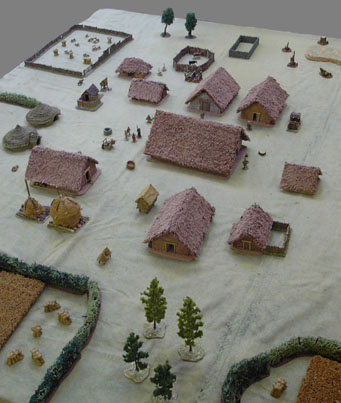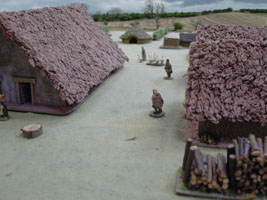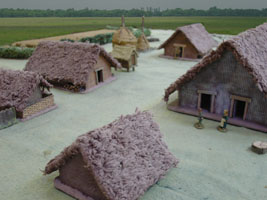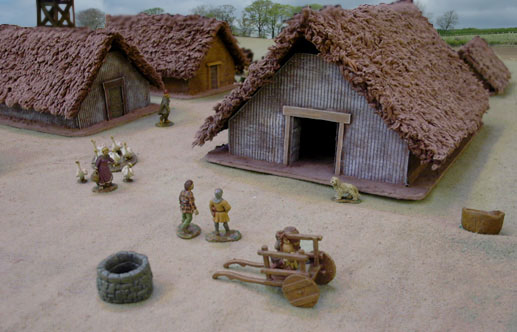The bad guys are attacking the village. In the village, there are innocent civilians, and two important people, whom the attackers particularly want dead. I played this as a dark-age fantasy game, with human defenders and goblin attackers, but you could very easily change this setting for another that suits your models and taste. If you can keep the details of the scenario a secret from one of the players, then this should be the attacker. The defender should be the "host" of the game, and be familiar with the details.

Plan view of an example table. It looks peaceful now, but any minute a horde of villainous types will attack. The watchtower/beacon is just out of shot on the hill at the top right.
Set up
The village is in the centre of the table. This consists of a cluster of buildings, with cover and obstacles of whatever sorts you can find. I used wood-piles, well-heads, goat-byres, beehives, chicken houses, haystacks, a cart, a kiln, and that sort of thing. You don't want a town, but instead a small village or perhaps extended farmstead with a mix of homes and other buildings (grain-stores, weaving huts, pigsties etc.). An important difference between the two kinds of building is that that the dwellings will have fires burning in them somewhere, whereas the other buildings will not. In the ancient world, lighting fires was difficult, and people habitually had fires burning in kitchens and in central hearths all the time, for heating and lighting.
Around the village is more terrain. I used fields, hedges, trees, fences, and I put out a fair few farm animals. In one corner of the table is a tower on a hill. In this, a beacon stands ready. This will summon reinforcements if lit.
The defender deploys his civilians. I used twelve civilian figures, that included the two VIPs (local lord and lady?), and a mix of men women and children, young and old. I also had a sheep dog, but I do not want to get bogged down in trivialities. The civilians all had the same statistics. For added scenario interest, these are deployed all outdoors, and not in a great huddle, but instead scattered about, going about their daily business. They may place them in the village itself, rather than all exposed near the table edges. However, the defender must place at least one outside the village limits, perhaps chopping wood in the nearby wood. The attacker ideally should not know this rule. The defender can use it to tempt the attacker to deploy near this one figure, and so just where the defender wants him.

You mark my words: any minute now this place will be a scene of havoc.
The defender
The defender then deploys his defending troops. The threat of attack was known about, but not the timing of it. The defender has just a few men, as there are many villages to defend. The trick with games like this is to keep them small, or else they take too long. I gave my defenders just three archers, four spearmen, and four cavalrymen. These were all decent troops, but nothing unusually good. No defending troops may deploy in the quarter of the table containing the tower. This may seem odd, but it is to make the scenario work. It can be rationalised as representing the fact that the attackers have been hiding and watching for the right moment to attack, and have noticed that the warrior manning the tower has just nipped back to the village to answer a call of nature.
Attackers
The attacker then decides where to come on. I was using a command and initiative system when playing my games, and this meant that the attacker was encouraged to arrive in a small number of groups rather than in one huge ring of individuals. If your rules allow every figure to move every turn, then this should not spoil the scenario, so long as the villagers were well distributed. Otherwise, they could all group together very quickly and hide away in one building, and you wouldn't get lots of little panicky fights, but instead one big slogging match which isn't nearly as much fun, and makes little use of the whole table.
My attackers were a rabble of twenty goblins and their very competent leader. The attackers should substantially out-number the defenders, but should be of lower quality. Their leader should be pretty able, because such a rabble would only come to such a battle if it had a strong unifying and motivating force. The attacker's brief is to kill all the civilians in the village, and do as much damage as possible. The attacking force has been given descriptions of the VIPs and so will know them when it sees them. About a third to a half of the attackers should be primarily missile-users.

Can't be long now. Brace yourself for hideous carnage.
Lighting the beacon
Neither side is carrying fire. Each must send a man into a building to get it (and perhaps only the defender will know which buildings have fire in them). A man is assumed to find in a building some easy way of carrying fire, such as a burning brand. The man can then go to the beacon and light it. Lighting it requires the man to get to the beacon and plunge the burning brand into it. On his next turn, he rolls to see if the beacon is alight, which it is half the time if he is busy fanning the flames and tending to it, but only a quarter of the time if he is busy being attacked. The roll is made every turn thereafter until it lights. The attacking force does not know about the beacon, and may not act to destroy it until a man has been seen carrying fire to it. Once fully alight, it cannot be destroyed. While it sputters into life, it can be pulled apart half the time if those doing the job are undisturbed, or (just like lighting it) a quarter of the time if there is a fight going on next to the beacon.
Once the beacon is lit, the reinforcements are on the way. They will not arrive for at least four defender's turns. The next defender's turn, they arrive if a 20 is rolled on 1d20. The next, if a nineteen is rolled, then eighteen and so on until they do in fact arrive. The force arriving is assumed to be overwhelming, and at this point all attackers flee and the game ends.
Victory Points
The points are allotted as follows:
- Per attacker dead: one point to the defender.
- Attacking leader dead: four points to the defender.
- Per civilian dead: two points to the attacker.
- Per VIP dead: six points to the attacker.
- Per house set on fire: one point to the attacker.
- Per four animals killed: one point to the attacker.
- Per defending soldier dead: no points to either side.
House burning
Two possibilities of deadlock exist. One is that the beacon is destroyed and cannot be lit, and so the reinforcements cannot be summoned and the game cannot be brought to a swift end. The other is that the civilians hole-up in the buildings and are too well defended to be killed by bow and sword. The same solution can break these deadlocks. A building can be set on fire. Though a beacon is a better thing for summoning the King's men, a burning house in a village will be investigated, so the defenders could set light to one of their own buildings for this purpose. Also, the attackers could flush out or burn the civilians who shelter in a building.
You will need rules for setting light to buildings. Roll 1d20 and try to roll 17 or more per full turn trying to do the job, and while not involved in melee. Add two to your roll per extra man helping and also carrying fire. Once it is alight, roll 1d20 and it will spread into a 1" diameter fire on a roll of 13+ (add one per man fanning the flames, and subtract one per man beating the flames from the same side of the wall as it was started, or per three from the other side (so if the building is set alight from the outside, and six people inside it are trying to beat out the flames, subtract just 2)). Every turn it will grow 1" in diameter (half an inch radius) on the building if the same roll is made. On rolls of 4 or less, it will shrink by the same amount, and will go out if it reaches a diameter of nought.
Anyone in a burning building must leave it or move to a part of it that isn't on fire. Once half the building is alight, there is a one in four chance every turn for each person inside that they will suffer a wound.
A fire three inches in diameter will attract the reinforcements. Once a fire has reached this size, the reinforcements will arrive, but not for four turns, and after that the 1d20 roll only gets easier by one point every two defender's turns, instead of every defender's turn.
Play-tests
In the first play-test, a party of men went out to light the beacon and were set upon by a gang of attackers. One man carrying a flaming brand broke away from the melee and ran for the tower. One attacker gave chase and caught him and delayed him enough for a second to arrive, and at the end of this melee one attacker remained standing and the beacon was unlit. Exciting stuff.
In the second play-test, all the attackers came on in one place, and then stood around shooting at what they could see. This allowed the defenders to charge in with their cavalry and cause a lot of damage, while the villagers took cover. Defender win.
In the third play-test, the attacking leader kept out of the fight and did little good. One man ran for the beacon and lit it unhindered. Meanwhile, the defending force killed a few attackers, but suffered itself as badly, and the attackers broke into the main long-house and killed a VIP. After the reinforcements had arrived and the dust settled, it was a narrow points-victory to the attacker.

It's just too damn quiet. The fiends will be laying into these poor innocent civilians in two shakes of a lamb's tail. Bound to be.